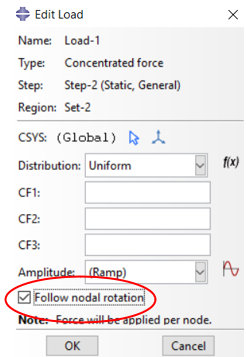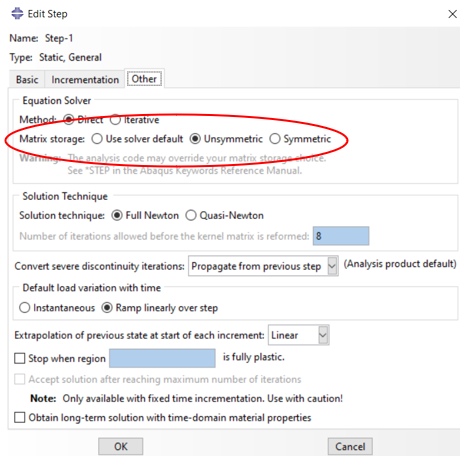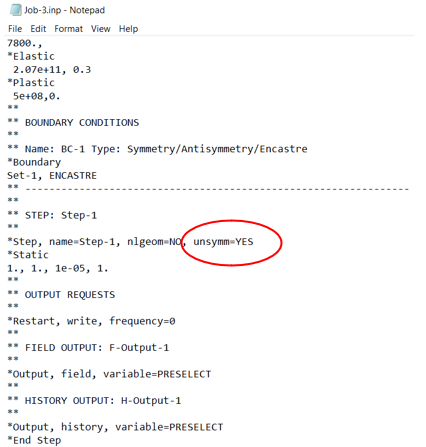When can we use follower loads, and is there a specific modification to use it?
- Training Group asked 2 years ago
- last edited 7 months ago
- You must login to post comments
What is “Follow nodal rotation” option in Abaqus? | Follower load, Follower force
The “Follow Nodal Rotation” option in Abaqus refers to a setting in the concentrated load (concentrated force) definition that allows the applied load to rotate with the associated node. When this option is enabled, the load remains aligned with the node’s local coordinate system throughout the analysis, even if the node undergoes rotational displacements. This option is particularly useful in scenarios where the applied load needs to be coupled with the rotational behavior of the structure. It allows for more accurate representation of real-world loading conditions, where the orientation of the load may change as the structure deforms.
To better illustrate this, let’s consider an example. Imagine a cantilever beam fixed at one end and subjected to a concentrated load at the free end. If the “Follow Nodal Rotation” option is disabled, the load will remain fixed in space and will not rotate with the beam as it deflects. However, if the option is enabled, the load will rotate together with the beam, maintaining its alignment with the local coordinate system of the node.
In large deformation analyses, the shape and configuration of the structure can significantly change throughout the simulation. As the structure deforms, the original nodal forces applied at the initial configuration may no longer accurately represent the actual forces acting on the deformed structure. This can lead to inaccuracies in the results.
By enabling the “Follow Nodal Force” option (follower load, follower force), Abaqus automatically updates the nodal forces during the analysis to account for the changing geometry and deformations. This ensures that the applied forces accurately reflect the current state of the structure, taking into consideration the large deformations and nonlinear behavior.
Enabling this option is particularly important in simulations involving materials with nonlinear behavior, such as plasticity or hyperelasticity, where the deformation response is highly dependent on the applied forces. By following the nodal forces, the analysis can capture the correct force-displacement relationship and provide more accurate results.
It’s worth noting that the “Follow Nodal Force” option may introduce additional computational cost due to the need for force recalculation at each step. Therefore, it should be used judiciously, considering the specific requirements of the analysis and the expected level of accuracy needed.
“Follow nodal rotation” limitations and considerations
When using the “Follow Nodal Rotation” option (follower load, follower force) in Abaqus, there are a few limitations and considerations to keep in mind:
- Compatibility: This option is only available for certain element types that support rotational degrees of freedom. Not all element types in Abaqus can accommodate nodal rotations, so it is essential to ensure that the selected elements are compatible with this option.
- Load Application: The “Follow Nodal Rotation” option is typically suitable for concentrated loads applied at a single node. It may not be applicable or meaningful for distributed loads or loads applied over an area.
- Load Orientation: With the “Follow Nodal Rotation” option enabled, the load orientation remains fixed relative to the local coordinate system of the node. This behavior may not be desired in cases where the load should maintain a fixed orientation relative to the global coordinate system or another reference frame.
- Stability: The “Follow Nodal Rotation” option can introduce additional complexities to the analysis, potentially impacting the stability and convergence of the solution. It is important to monitor the convergence behavior and perform appropriate checks to ensure the accuracy and reliability of the results.
When you have a large displacement analysis or finite sliding in ABAQUS, you have to use follower loads to change the direction of the force loaded on a node. The follower load allows the force to rotate with the node to which it is applied, and it will change the direction of the force as the node rotates. You can activate follower load by selecting the “Follow nodal rotation” option (see figure 1) when you have Concentrated force or Moment.

Figure 1: selecting the “Follow nodal rotation” option
Note that the stiffness matrix will become unsymmetric when using follower load, so you have to use unsymmetric matrix storage. Either you can do it in the graphical interface or input file (see figures 2 and 3).

Figure2: Selecting Unsymmetric matrix through graphical interface

Figure3: Using Unsymmetric matrix through the input file
- Training Group answered 2 years ago
- last edited 7 months ago
- You must login to post comments
Please login first to submit.
